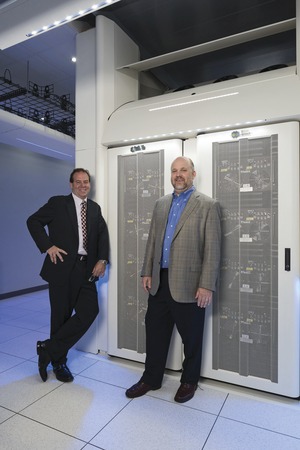
The Three Musketeers of data-center transformation—Skanska's Jakob Carnemark and Inertech's Earl Keisling and Gerald McDonnell—put their reputations on the line when selling telecommunications company TELUS the first installation of Skanska's smart, ultra-green modular data center. They claimed Inertech's new, patented cooling system would cost 80% less to operate than a conventional chilled-water system.
 |
| CARNEMARK |
Carnemark, the mastermind behind the design-build package—complete with intelligent management software—was so confident about the new cooling system that he risked more than his reputation: He gave TELUS a performance guarantee that said Skanska would pay incremental utility costs if the Rimouski, Quebec, facility used more energy than had been budgeted.
Since the servers went live last August, "the system's performance is exceeding our very high expectations, even with very low initial loads," says Lloyd Switzer, senior vice president for network transformation at TELUS. Often, "our lighting load is greater than the mechanical load."
Carnemark started on his green data-center crusade more than eight years ago. Seeing a growing market for data centers, he was extremely frustrated by two things: data centers' gargantuan appetite for water and power for cooling and a lack of innovation in the construction industry.
"Data centers are an unsustainable business model" due to skyrocketing cooling overhead costs and up-front capital costs for future capacity, says Carnemark, Skanska USA Building Inc.'s senior vice president for mission-critical facilities. Without change, "the business will collapse under an unsupportable waste of resources and capital," he predicts.
Skanska's phased construction, in which server modules are added as demand rises, can reduce initial capital costs by 30% to 40%. But the crux of the Skanska model's savings is in operations.
TELUS is so thrilled with its facility that it already has a twin data center half complete at another site in Canada. And Skanska recently kicked off five projects with other clients. The activity "is driven by the cooling solution," says Carnemark.
Inertech's eOPTI-TRAX is a distributed, closed-loop system that saves resources by operating mainly in a chiller-less, "free cooling" mode. It is 10 to 25 times more efficient than a chiller plant, according to a recent report by consulting engineer Norman Disney & Young. And it is six to 11 times more efficient than evaporative cooling and air cooling.
Carnemark and Keisling, Inertech's president and CEO, see data-center retrofits as the hottest market. Cooling accounts for 90% of data-center overhead. An eOPTI-TRAX retrofit can slash that to 5%, says Carnemark.
One client currently spends $20 million each year to power its data centers. "We can knock it down to $2 million," says Carnemark. "That's $18 million straight to the bottom line."
Keisling and McDonnell, Inertech's chief innovations officer, hold patents on eOPTI-TRAX, but they say Carnemark is the visionary who inspired them. "Jake came up with parameters," says Keisling, a former mechanical design-build contractor. "He is a big thinker with an uncanny way of looking outside the box."
Carnemark "relentlessly" thinks about ways "to disrupt traditional data-center design," says Switzer, who is talking to Skanska about retrofits.
Carnemark's next disruption may be coming soon. He is working with software providers to develop enterprise-wide asset management systems for real estate portfolios. He figures that, using eOPTI-TRAX and smart facilities management, he could help big firms save $300 million to $400 million a year.
"We are laser-focused on the large-enterprise financials, telecoms and government enterprises," says Carnemark.




Post a comment to this article
Report Abusive Comment